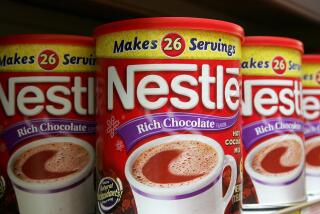A Job With Melt-in-Your-Mouth Appeal
- Share via
KILCHBERG, Switzerland — Hans Geller has a dream job: He’s paid to eat Swiss chocolate.
As master chocolatier with Lindt & Spruengli, Geller has spent every working day for the last 40 years developing and sampling premium chocolate bars, balls, batons, bunnies and any other sweet delights that roll off the production lines.
He is a happy man.
“I have never had the feeling that I can’t look at another chocolate bar,” he says, patting his trim stomach to illustrate that he’s no glutton, and passionately evoking the pleasures of fine dark chocolate with a brandy or cup of strong coffee.
It is a passion shared by many of Geller’s compatriots. The Swiss claim to be world champion chocolate consumers, tucking into a hefty 26.2 pounds per person per year -- although this figure also includes chocolate bought by tourists in Switzerland. Germany follows at 22.3 pounds, while Americans average 10.8 pounds, according to industry statistics.
The Swiss sold 142,000 tons last year worth $92.1 billion. Nearly 70,000 tons went for export -- up 4.7% from 2001 -- with Germany the biggest customer.
Franz Schmid, director of Chocosuisse, which groups all the Swiss manufacturers, describes products like Lindt chocolate or Nestle’s Toblerone as “Swiss chocolate ambassadors around the world.”
Swiss chocolate prowess dates to 1819, when Francois-Louis Cailler opened a mechanized chocolate production facility near Lake Geneva.
At that time, chocolate was brittle, rough-surfaced and bitter. In 1867 the first milk chocolate was produced when an entrepreneur managed to combine chocolate with milk. The real breakthrough came in 1879 when Rodolphe Lindt hit upon the idea of adding cocoa butter to smooth out the texture in a shell-shaped machine called a conche, which churned and turned the mixture for three days. The result was a superior chocolate that melted in the mouth.
Lindt sold his factory and money-making technique to another chocolate maker, Rudolph Spruengli, in 1899.
The “conching” technique made Switzerland a chocolate superpower, seducing high-society taste buds around the world. Since then, there have been many rivals but -- the Swiss argue -- few equals.
The recipe for success is a strictly guarded secret. Swiss and European Union laws allow manufacturers to use up to 5% vegetable fat as a substitute for the more expensive cocoa butter. But all Swiss manufacturers insist on using only cocoa butter, according to Chocosuisse.
“We don’t need vegetable fat and we don’t want it,” insists Schmid. It is a sentiment echoed by Lindt & Spruengli, which says its uncompromising stance is the reason for its success.
The company has an international work force of 6,000, plants in Switzerland, Italy, France, Germany and the United States, and sales of $1.2 billion last year. It has strengthened its position in the U.S. market since it purchased the tradition-laden Ghiradelli Chocolate company in San Francisco in 1998.
The company doesn’t often open its headquarters on Lake Zurich to outsiders, but recently allowed journalists to visit.
Even for unrepentant chocoholics, the smell of chocolate and the scale of production is overpowering. Mighty machines devour huge quantities of cocoa mass, sugar and cocoa butter, milk powder and a secret mix of spices. It then churns them out in a thick liquid mass to be refined, frozen, molded and aerated depending on the final product.
The factory operates 24 hours a day in the peak July, August and September period preparing for the Christmas market. It can produce 18,000 chocolate bars an hour and 700 Lindor balls a minute.
Workers are allowed to help themselves provided they respect strict hygiene rules. Strikingly, almost nobody is obese.
“Once you’ve been here a couple of months, you really don’t feel like eating too much chocolate,” says Bernhard Winzeler, a manager. Almost simultaneously he plucks his favorite praline from the conveyor belt and pops it in his mouth.
The experts say that quality dark chocolate cracks when a piece is broken off, whereas milk chocolate makes a softer sound.
To appreciate its full flavor, chocolate should be allowed to spread slowly over the tongue. Good chocolate melts like butter but doesn’t stick to the roof of the mouth or feel gritty.
Geller, the taster, has lost track of how many chocolate bars he has sampled. He and his fellow tasters arrive for work at 7 a.m. to test the night’s production, and repeat the procedure in the afternoon. Given that they “sample and spit,” Geller says that he rarely eats more than the equivalent of one bar -- 3.5 ounces -- a day.
That doesn’t prevent him from nibbling in his spare time, he says, adding that his favorite is a dark chocolate with a 60% cocoa content (two-thirds of people prefer the milk variety).
Geller says all his team members have a science or nutrition background and undergo two years of training.
But in addition to the professionals, Lindt & Spruengli also regularly uses enthusiastic amateurs. It has a network of 200 people in the Kilchberg area that it can call on to try new products.
By means of payment, all the volunteers receive -- what else? -- a box of chocolates.
More to Read
Eat your way across L.A.
Get our weekly Tasting Notes newsletter for reviews, news and more.
You may occasionally receive promotional content from the Los Angeles Times.










